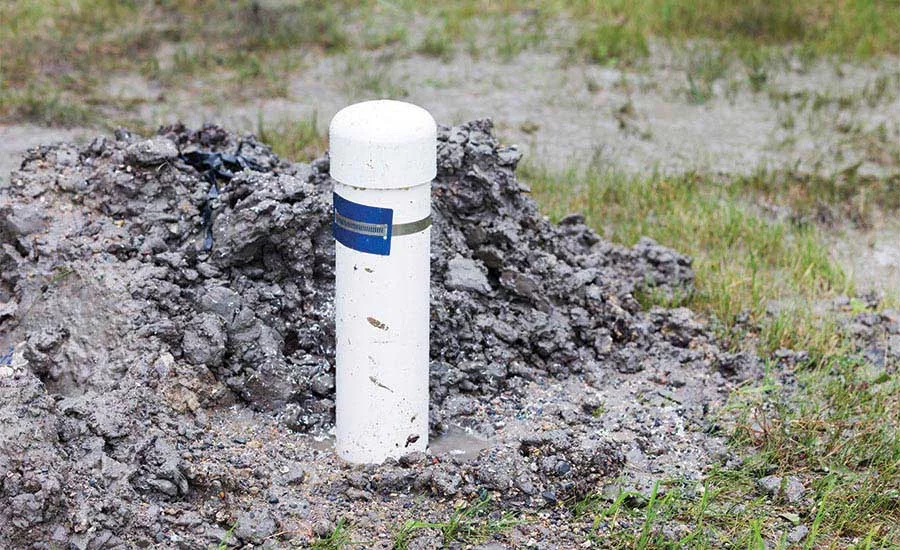Tips for Getting from Drilling to Casing

Most of us in the water well industry know our areas well enough to be able to preplan a well and go to the location with the right tools and equipment. But sometimes Mother Nature, or geology, fools us into problems. Knowing what to expect sure helps, but sometimes we run into the unexpected. Murphy’s Law throws a curve. At depth, we can’t see the bit any better than a blind man could. We have to use the surface clues and indicators we have to complete the well.
The most common problem is when we drill a shallow, low pressure zone knowing the productive formation is deeper, and we have to control it to get there. The lower formation may be pressured up, meaning we may have a flowing well on completion. This requires mud with a higher specific gravity than the shallow formation will stand. In this case, good mud is a must. The specific gravity of the mud must be low enough to not lose mud in the upper, low pressure formation, and still hold the higher pressure formation back until you have finished the well. Mud that builds a good, thin, tough wall cake is key. Natural clays won’t do this, so you will need some thoroughly mixed — and properly hydrated — bentonite mud with area-specific additives.
Sometimes, on a big job, it’s money and knowledge in the pocket to drill a test hole. I have done this many times. It usually provided a more harmonious outcome. I don’t drill the test hole right where I’m going to put the production well. That way, if I get my finger in the wringer, I can learn from it before I drill the production hole. Test holes are usually the smallest diameter you can drill. They provide formation and pressure data, so a few yards from the production well does not usually make much difference.
In a case where you cannot control the pressure between two or more formations, additional casing strings may be required. Starting at the bottom, consider the size of the final well and then increase size for the next section going upward. I have seen wells with five different casing sizes to complete. Area knowledge and your test hole will tell you what you need to know.
When drilling the production well, start with mud that suits the uppermost formations. Drill this, set casing, get a good seal and then treat the mud for the next interval. In this way, drillers will be prepared for the wonderful surprises that geology throws their way. You don’t want sudden lost circulation or unwanted flow while drilling.
On a side note, I’m going to say something about the difference between mud weight and viscosity that I’ve said many times before: Weight is a measure of specific gravity. Viscosity is just that — viscosity. To illustrate, in many of my seminars, I hold up a canning jar of gear oil and a canning jar of water. I ask the class which is heavier. It never fails that somebody will tell me that the gear oil is heavier. I then pour the water into the gear oil, and it promptly sinks to the bottom! Water is heavier than oil, even though the oil is much thicker. Don’t confuse the two.
A light, thick, fresh mud will usually control even the loosest, flowing sands. On the other hand, if you are trying to control an overpressure formation, you will need to build mud weight. In the oilfield, we used barite to build weight with enough gel to keep it suspended.
Sometimes, you can just turn off the makeup water, and the mud will get heavier. This is common practice in the water well industry, but is hard on pumps and equipment. If you drill into a high pressure formation and the well is “trying to come see you,” sometimes you can drop the suction to the bottom of the pit and pick up enough solids to get the specific gravity (weight) up enough to control the hole. In this section of the hole, try to anticipate what you are going to see and be ready. Preparation is cheaper — and faster — than fixing a screw-up.
When you reach total depth and are ready to set casing, make sure to circulate and condition the mud and the hole, so it will remain stable until you get the “steel wall cake” in it. Watch your pit level for loss or gain, and adjust your mud accordingly. I have seen many drillers trying to save time just hit bottom and come out of the hole, usually swabbing behind the bit. They get out and find that the higher pressure formation is now flowing into the lower pressure formation. That is a nearly incurable lost hole and may be a disaster for neighboring wells. In my area, we have a pressured up saltwater formation that will flow into the producing formation. Over the years, I’ve seen it ruin dozens of good wells because the wells were not built properly. They had no seal between the formations. This allowed the contractor to cash the check and get gone, while all the customer’s neighbors were suddenly irrigating with brine, which can be pretty hard on the azaleas.
A little thought and planning, and the right tools and equipment, can make the difference.
As always, if you have any questions, don’t hesitate to call or email me. Keep ’em turning to the right!
For more Wayne Nash columns, visit www.thedriller.com/wayne.
Looking for a reprint of this article?
From high-res PDFs to custom plaques, order your copy today!





